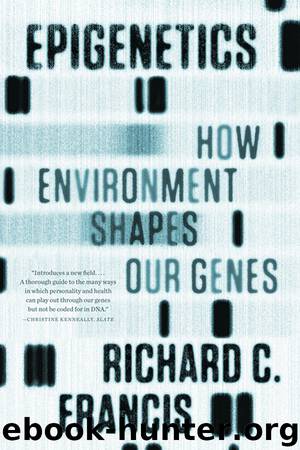Epigenetics by Richard C. Francis

Author:Richard C. Francis
Language: eng
Format: epub
Publisher: W. W. Norton & Company
Published: 2011-06-26T16:00:00+00:00
Chapter 10
Sea Urchins Are Not Just to Eat
THE SEA URCHIN, REVILED BY OCEAN REVELERS FOR ITS SPINES but beloved by sushi aficionados for its gonads, has a starring role in developmental biology.1 Much of what we know about the earliest stages of development comes from studies on sea urchins. Fertilization—the union of sperm nucleus with egg nucleus—was first observed in sea urchins. Sea urchins have also figured prominently in studies of what happens next: a series of cell divisions through which the fertilized egg, or zygote, is transformed into a ball of generic cells called a blastula. The cells in the blastula are generic in the sense that they have none of the distinguishing features of any of the cell types found in adult sea urchins, such as blood cells and neurons (sea urchins have neurons but no brains). These blastula cells are also generic in another sense: they generate all of the adult cell types. We call these generic blastula cells embryonic stem cells. This is as true for humans as for sea urchins.
The process whereby the zygote gives rise to the blastula, and the blastula gives rise to an animal with spines and gonads—or brains and gonads, as the case may be—is among the most wondrous in the universe. This process is also one of the most difficult for the human mind to digest. Our intuition, so useful in other scientific contexts, tends to fail us here, tends to lead us astray. There is also a lot at stake here. The ultimate goal, after all, is to understand how we come to be what we are, how you came to be you. It is not surprising, therefore, that this process, which we will simply call development, is a subject with a long history of dispute.
There are a number of points of contention, but for our purposes we can divide the disputants into two camps. In the first, we have those who assert that, despite appearances to the contrary, the zygote actually contained you. This is known as preformationism, which in its most extreme form asserts that your development was merely a matter of growth. The extreme form of preformationism is also the most primitive; far more sophisticated versions were developed during the eighteenth and nineteenth centuries.2 The more sophisticated versions of preformationism assert that you are latent in the zygote and your development is the process of the “latent you” becoming the “manifest you.” This latent you need not resemble the manifest you at all. But—and this is the essence of preformationism—the particular form that constitutes you is entirely present, however latently, in the zygote. Nothing in the environment contributes to your adult form. Nor did your manifest you come to exist as a result of development; it was there from the outset.
The last claim in particular distinguishes preformationism from the second type of developmental explanation, known as epigenesis.3 From the epigenesist perspective, you do not exist prior to development, either manifestly or latently. Rather, development is the process whereby you come to exist.
Download
This site does not store any files on its server. We only index and link to content provided by other sites. Please contact the content providers to delete copyright contents if any and email us, we'll remove relevant links or contents immediately.
| Fossils | Game Theory |
| Genetics | Molecular Biology |
| Organic | Paleontology |
Sapiens: A Brief History of Humankind by Yuval Noah Harari(14242)
Sapiens by Yuval Noah Harari(5293)
Pale Blue Dot by Carl Sagan(4904)
Homo Deus: A Brief History of Tomorrow by Yuval Noah Harari(4818)
Livewired by David Eagleman(3680)
Origin Story: A Big History of Everything by David Christian(3648)
Brief Answers to the Big Questions by Stephen Hawking(3368)
Inferior by Angela Saini(3276)
Origin Story by David Christian(3145)
Signature in the Cell: DNA and the Evidence for Intelligent Design by Stephen C. Meyer(3070)
The Gene: An Intimate History by Siddhartha Mukherjee(3046)
The Evolution of Beauty by Richard O. Prum(2936)
Aliens by Jim Al-Khalili(2785)
How The Mind Works by Steven Pinker(2728)
A Short History of Nearly Everything by Bryson Bill(2627)
Sex at Dawn: The Prehistoric Origins of Modern Sexuality by Ryan Christopher(2481)
From Bacteria to Bach and Back by Daniel C. Dennett(2441)
Endless Forms Most Beautiful by Sean B. Carroll(2428)
Who We Are and How We Got Here by David Reich(2396)
